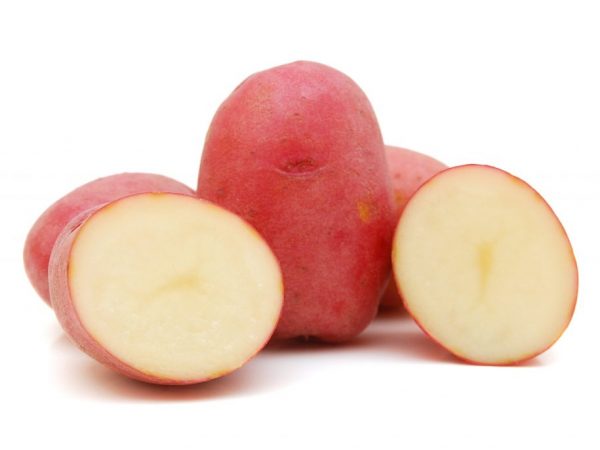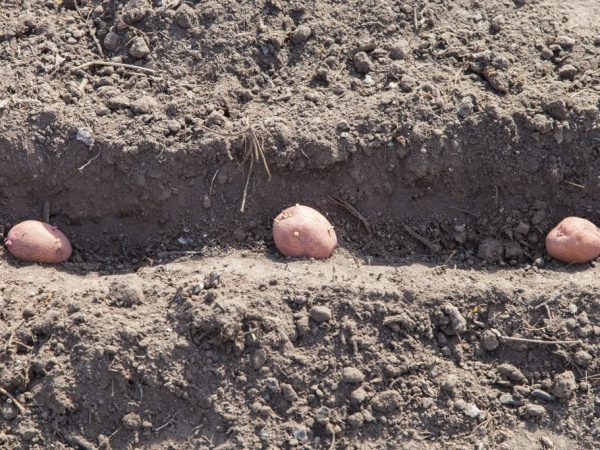Characteristics of the potato variety Labella
The Labella potato is a popular Varietal variety of the nightshade. Observing all the rules and recommendations for caring for the plant, the vegetable grower is able to get a bountiful harvest.

Characteristics of the potato variety Labella
Characteristics of the Labella variety
The Labella potato variety adapts well to different climatic conditions, therefore it is suitable for conventional and industrial cultivation in different regions of the country. According to the description, Labella is an early Variety.
The bush is upright, compact, without spreading branches. The leaves are of a deep emerald hue, small, slightly wavy at the edges. During flowering, small pink-purple flowers appear on the plant. The variety has a well-developed root system.
The potato is medium in size, elongated-oval, its weight is from 78 to 102 g. The peel is thin, dark red. The eyes are set shallow (superficial), the flesh is yellowish. The percentage of starch in fruits is not more than 12-15%. The tubers have an average boiling point.
The keeping quality of the tubers is good, so they are well transported over long distances. Marketability - not less than 90%. Labella potatoes are famous for their high content of B vitamins, minerals and protein.
Advantages of the Labella variety
According to the characteristics, the seed material of the Labella variety has the following advantages:
- high yield rates - up to 265 c / ha, the maximum possible - 345 c / ha;
- sweetish, not watery taste;
- versatility in application;
- the same size of potatoes;
- drought tolerance and increased heat tolerance;
- resistance to the most common diseases;
- high commercial quality.
Labella potatoes are susceptible to frost.
Planting Labella potatoes
According to the description, Labella is an early crop, but planting dates differ depending on the climatic conditions in the cultivation area.
The most optimal period is mid-April: at this time the soil is already well warmed up. An important step is the selection of suitable root crops. At the same time, the following criteria are adhered to:
- selection of potatoes with a large number of eyes: they are able to give many shoots;
- selection of a clean material that is not affected by fungal diseases.
Seeds are recommended to germinate in advance. To do this, take a small container, where the soil is poured with a thin ball and the fruits are folded. After that, the box is exposed to the light so that the pagons begin to germinate. After the roots are sorted into a separate container and planted in the ground.
Soil preparation
The soil is prepared immediately after harvesting. All potatoes are removed from the soil and inorganic fertilizers are applied. Large lumps should not be broken: then the soil will freeze well, weed seeds and pest embryos will die in it.
In the spring, the land is cultivated, fertilizers are applied to it, loosening is performed, after which the site is considered completely ready for planting.
Planting potatoes

Keep a distance when planting potatoes
To get a rich harvest, it is recommended to plant not only large potatoes, but also small change.
Root crops are treated with protective equipment before planting.
First, trenches are dug, the depth of which varies depending on the type of soil. On average - 6-8 cm. The distance between the rows should be more than 70-75 cm. Potatoes are laid out every 30 cm and sprinkled with earth.
Highlights of care
The ripening period depends on various factors: weather conditions and how the grower looks after the crop. In order to avoid mistakes, all the nuances are taken into account. Labella's care is standard.
Watering
The bushes are watered during dry periods, using 10 to 15 liters of water per plant. It is better to water at the root in the evening. This is necessary so as not to damage the plant, because if you pour the plant in the morning, the sun's rays will burn the leaves.
Fertilizer
Top dressing plays an important role in growing potatoes. If fertilizers are not applied in time, the plant will not be able to develop normally, but an excess will negatively affect the bush.
The most optimal feeding option:
- carry out the first feeding during disembarkation (1 tbsp. of the drug "Solution" or urea in a bucket of water);
- perform the second feeding at the beginning of budding (potassium phosphate and ash are diluted in 10 liters of water);
- the third - during the flowering period: it promotes faster formation of potatoes.
Prophylaxis
The Labella variety tolerates the late blight epidemic well and rarely suffers from viruses, but as a preventive measure, it is necessary to treat the plant with herbicides.
Every few years, the place where the crop is grown is changed. It is good to plant potatoes in areas where legumes or cabbage previously grew. Do not plant root vegetables in place of peppers or tomatoes.
Conclusion
Labella potatoes stand out from the rest with stable yields, resistance to hot climatic conditions and harmful organisms. Ease of growing makes it especially popular among beginner gardeners.


